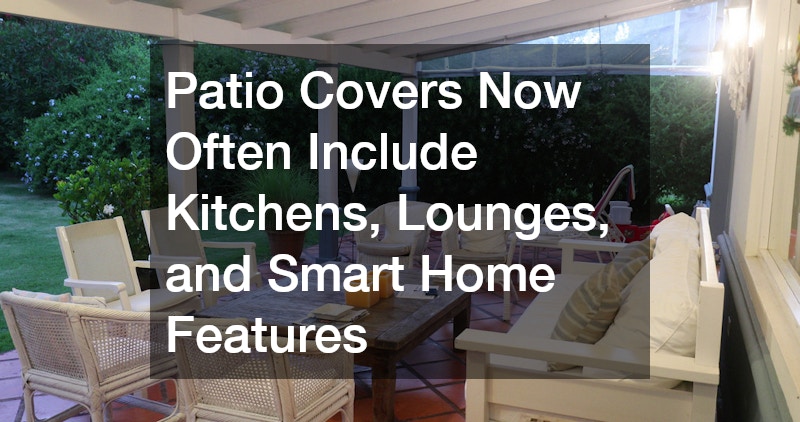Choosing the right patio cover can significantly enhance your outdoor living space, offering protection from the elements and adding aesthetic value to your home. With numerous companies offering a variety of materials, costs, and styles, making an informed decision can be daunting. This article aims to thoroughly compare patio cover companies based on these three crucial criteria: materials, cost, and style.
What are the most popular materials for patio covers?
Wood
Wooden patio covers are renowned for their classic appeal, offering a timeless look that many homeowners find appealing. However, the durability of wood varies across different types of timber, with cedar and redwood being particularly sought after for their resilience and natural resistance to decay.
Maintenance requirements for wooden patio covers include regular sealing and staining to protect against weather-related damage. It’s crucial to note that some companies offer pre-treated wood options that promise greater longevity and reduced maintenance needs.
When comparing manufacturers, consider both the quality of the wood and the craftsmanship in construction. A well-constructed wooden patio cover not only enhances the aesthetic appeal of your home but also increases overall property value.
Aluminum and Steel
Aluminum and steel are increasingly popular choices for patio covers due to their durability and modern look. Aluminum, in particular, is lightweight and resistant to rust, making it an excellent choice for humid climates where moisture can be an issue.
Steel, on the other hand, offers unmatched strength and can support larger structures, but it requires a protective coating to prevent corrosion. Companies often provide different grades and finishes, allowing customization to match existing architecture and landscaping.
An important consideration when selecting metal patio covers is their energy efficiency. Certain companies offer thermally broken aluminum frames, which can help reduce heat transfer, keeping the area underneath cooler during hot summer months.
How do patio cover costs vary between companies?
Initial Installation Costs
The initial costs of patio covers are influenced by material choice, design complexity, and the company’s pricing structure. Wooden structures tend to be costlier upfront due to the material and skilled craftsmanship required.
Aluminum and steel options, while generally more affordable than wood, can vary greatly depending on the manufacturer and additional features such as built-in lighting or motorized retractability. It’s advisable to get quotes from multiple companies to compare costs effectively.
It’s essential to consider the reputation and reviews of companies, as those with a proven track record often provide better quality products and installation, justifying higher initial costs. Customizing the design can also impact the price significantly, depending on the level of detail involved.
Long-term Value and Maintenance Costs
The long-term value of a patio cover involves understanding the ongoing maintenance required to keep the structure in optimal condition. Wood typically demands more maintenance than metal, requiring regular treatments to protect against weather and pests.
Conversely, aluminum and steel covers generally need less upkeep, translating to lower long-term costs. When selecting a company, inquire about warranties and maintenance services to better assess future expenses.
Investing in quality materials upfront can lead to savings over time. High-grade aluminum, for instance, maintains its appearance with minimal care and resists fading, making it a popular choice for those seeking long-term value.
Which styles are trending in patio covers?
Customization and Design Options
Contemporary patio covers are shifting toward greater customization, allowing homeowners to tailor designs that complement their home’s architecture. From minimalist to ornate, the range of stylistic options is vast and varied, each reflecting personal taste and lifestyle needs.
Companies today offer features like retractable awnings, integrated lighting, and even smart home connectivity, which enhance functionality while providing aesthetic value. As trends evolve, many manufacturers are increasingly focusing on designs that blend seamlessly with modern architectural styles.
It’s crucial to work with a company that offers a broad selection of materials and finishes to ensure the final product meets your vision. Consider the flexibility in design options and the capability to incorporate popular trends when selecting a patio cover provider.
Integration with Outdoor Living Spaces
The most appealing patio covers integrate effortlessly into outdoor living spaces, enhancing both utility and visual charm. Companies are focusing on creating unified looks that connect the patio with its natural surroundings and adjacent structures.
Natural materials, subtle finishes, and clean lines are trending, emphasizing a harmonious transition between indoor and outdoor environments. The key is to select a design that not only meets functional needs but also augments the existing aesthetics of your home.
Patio covers are increasingly being designed with multi-functionality in mind, allowing for the inclusion of outdoor kitchens, lounges, and smart home integration. A company with diverse offerings can assist in creating a customized space that meets all of your outdoor living aspirations.
When comparing patio cover companies, it’s essential to consider material quality, cost implications, and stylistic offerings. By understanding these factors in depth, homeowners can make informed decisions that best suit their budget, aesthetic preferences, and long-term goals, ensuring that their chosen patio cover meets all their outdoor living needs.






